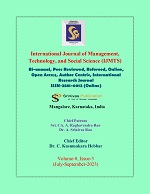Colonialism and Cross-Cultural Ties in Sea of Poppies
Main Article Content
Abstract
Purpose: The present study will emphasize Colonialism and Cross-cultural ties in the Sea of Poppies of Amitav Ghosh. "Colonialism" describes a trend that emerged towards the latter of the 20th century. Modernism was in decline after modernity, and postmodernism emerged. Postcolonial literature, mostly novels, addresses important human concerns including culture across borders and the quest for identity. This paper aims to show how differences merge in the novel to create a mixed society made up of persons from varied social and geographic backgrounds who voyage on the ship Ibis to a distant land where they unwillingly forge new identities.
Design: Peer-reviewed journals, educational websites, research articles and both national and international periodicals were used to compile information needed for this topic. The methodology used for the study is done by gathering, analyzing, and comprehending prior knowledge. Amitav Ghosh's selected works are thoroughly understood and read, besides research papers on related topics. The researcher will adhere to the guidelines in the APA Manual during the study.
Findings: The purpose of the study will be to find out about Colonialism and identity in Amitav Ghosh’s Sea of Poppies, after reviewing many publications, like essays, theses and books. It is proved cross culture is not a static presence; in each given circumstance it differs from one person to person, region to region, culture to culture, and country to country.
Originality: The proposed study is unique as it will focus primarily on colonialism and cross-cultural ties in sustaining identity, which will be achieved by understanding why Nations were eliminated, including individuals and communities.
Paper Type: Analytical Paper
